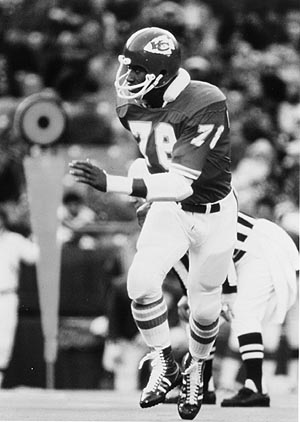Gladiator
Bobby Bell was inducted into the Pro Football Hall of Fame on July 30, 1983 because, in his tenure with the Kansas City Chiefs from 1963 and 1974, he handled his left linebacker's job as well as anyone who ever played the position.
But many who played with and against the 6-4, 225-pound gladiator feel he might have won equally lasting acclaim at several other positions, either on offense or defense.
"Bobby is the most versatile athlete I ever coached," Chiefs mentor Hank Stram often commented. "You hear a lot about all-around football players but you don't really see many. There isn't a job Bell couldn't do and do well."
 |
|
Bobby Bell |
As it was, Bell excelled in a wide variety of ways in two decades of gridiron play in high school, college and the pros. He was first a halfback and then an all-state quarterback at his hometown high school in Shelby, North Carolina. He was a freshman quarterback at Minnesota but wound up as an All-America tackle. And at Kansas City, he started as a defensive end before moving to linebacker. For the Chiefs, Bobby even snapped the ball on punts and kickoffs, a skill he gained in college when a team need arose. Many feel that Bell was the stabilizing influence in Kansas City's high-quality kicking game over a number of years.
Bell was the fifth player from the American Football League and the first Chiefs' player to be elected to the Pro Football Hall of Fame. Kansas City team owner and AFL founder Lamar Hunt preceded all AFLers with his 1972 election to the Hall.
Bell was built in the shape of an inverted pyramid with massive shoulders tapering down to a 32-inch waist on his 225-pound frame and, with a ferocious look on a ruggedly handsome face, he presented a fearsome appearance on the gridiron. He had the ability to go with that appearance and the physique and the strength to withstand the punishment he had to take. But he could deal out his own punishment and he became respected as one of the most effective and damaging tacklers in the league. Toss all of that in with exceptional agility and speed - he was regularly timed at 4.5 in the 40-yard dash - and you had all the attributes of the perfect outside linebacker.
Stram recognized all of these abilities when Bell first joined the Chiefs in 1963, but the Chiefs were blessed with excellent linebackers that year. There was a shortage of players up front so Bell became the team's left defensive end.
"The most important question was not where Bobby could play," Stram, who coached Bell throughout his pro career, remembered. "He could have helped us at a number of positions, even on offense. The real question was where we needed him most."
In his rookie season, Bell weighed just a little over 210, small by modern-day standards for a defensive lineman. But he tackled the job with characteristic enthusiasm and determination and soon became one of the top pass-rushers in the AFL. In his second campaign in 1964, he won All-AFL honors as a defensive end.
During Bell's tenure on the defensive line, Stram pioneered the so-called "stack" defense alignment that called for Bobby to drop out of the Chiefs' 4-3 formation and become a fourth linebacker. Stram used the ploy effectively on passing situations. Today, the four-linebacker is commonplace in the NFL.
Where would you rather be?
Although Marv Levy's interests and educational resume may be more typical of an academician, his career resume is unmistakably that of a successful football coach - a very successful football coach. So successful, in fact, that it has earned him the ultimate form of career recognition, membership in the Pro Football Hall of Fame, only the eighteenth coach to be so honored.